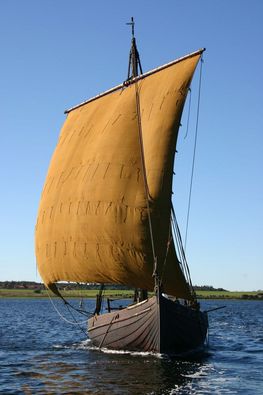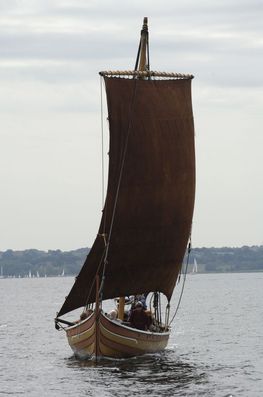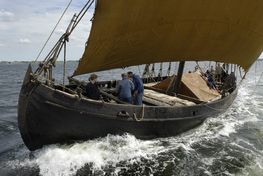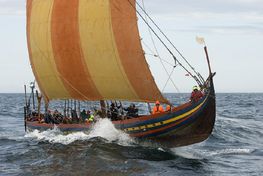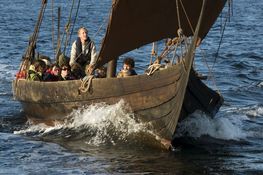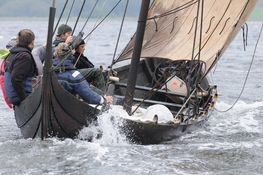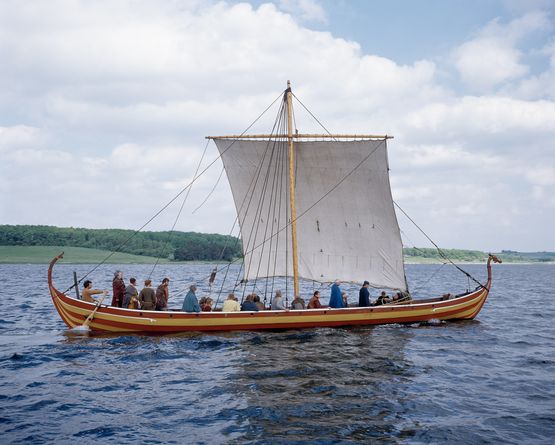
Trial voyages and voyage documentation
For more than 110 years eager amateurs have carried out trial voyages with reconstructed ships and boats as can be seen from the following examples:
1893, Viking (Gokstad), Norway-USA, Magnus Andersen
1947, Kon Tiki (free reconstruction), Peru-Polynesia, Thor Heyerdahl
1976-77, Brendan (free reconstruction), Ireland-Canada, Tim Severin
1984-86, Saga Siglar (Skuldelev 1), around the world, Ragnar Thorseth
2007-08 The Sea Stallion from Glendalough (Skuldelev 2) Roskilde-Dublin-Roskilde, The Viking Ship Museum
Some of the voyages were sailed with ‘floating hypotheses’, some with exact reconstructions. The documentation for these voyages is very variable. They have in common the fact that they awoke great public interest and contributed a great deal to illustrating the challenges that lay in sea voyages in the past.
An actual trial voyage does, however, require that a series of experimental conditions is decided upon and maintained. Here is a maximum list of requirements for a voyage under medieval conditions:
- A faithful reconstruction of a well-documented shipwreck
- A voyage through waters similar to those of the ship’s original operational area
- No use of engines
- No external help except in an emergency
- No navigational methods or instruments which were not known at the time
- No fixed schedule
- Use of natural harbours rather than modern harbour facilities
It is very difficult to meet all of these requirements at one and the same time. It may be necessary to dispense with some of them, for example authentic clothing and subsistence. In any circumstance there must be sufficient equipment on board to ensure the life and health of the crew.
Voyage documentation at the Viking Ship Museum
The Viking Ship Museum is building on three decades of experience in trial voyages, but has only limited funds to carry out time- and resource-demanding trial voyages. The museum’s ships already sail regular summer cruises under the auspices of the Museum’s Boat Guilds. During these voyages, the ships use only sail and oars, apart from a few stretches when they are towed under motor power. The Boat Guilds’ voyages with the museum’s vessels attain therefore a particular significance as a rare source of first-hand experience and data for historical sailing research. In order to exploit this potential, since 2002 all summer cruises have been logged.
So far there are logbook entries for the Sea Stallion from Glendalough (Skuldelev 2), Ottar (Skuldelev 1), Roar Ege (Skuldelev 3), Helge Ask (Skuldelev 5), Ruth (a Danish sloop from 1854), Rana (a Norwegian Nordland fishing boat from 1892) and Victoria (a little Danish eel drifter from 1904. The documentation is based on the following elements:
- Tailor-made voyage logbook, kept by the watch on duty
- Portable GPS, permanently connected to a 12 V battery
- Photographs and video (occasionally)
- Interviews and individual reports
- Annual analysis in order to build up a database
Boat speed and travel speed
One of the many aspects which can be investigated with the aid of voyage documentation is the term speed. In an evaluation of boat speed and travel speed during a voyage use can be made of the following definitions:
- Speed through the water: Distance logged/time (measured with the log)
- Speed over ground: Distance over ground/time
- Travel speed at sea: Distance harbour to harbour/time at sea (including breaks at anchor)
- Travel speed total: Distance harbour to harbour/duration of the voyage
- Days of travel: Duration of the voyage, rounded up to whole days
Here are examples of the different kinds of speed: When Ottar (Skuldelev 1) sailed to Eastern Norway in the summer of 2003, the ship could, over part of the voyage – a distance of 147 nautical miles (Anholt-Lyngør), maintain an average speed over ground of 4.5 knots. This corresponds to 108 nautical miles per 24 hours and gives a good impression of the ship’s potential speed with a light to gentle breeze from the stern. The whole voyage from the coast of Northern Zealand to the coast of Eastern Norway took in all seven travel days as it was necessary to seek shelter in Anholt Harbour due to a strong headwind. The resulting travelling speed overall, over the shortest possible distance of 189 nautical miles on the route from Hundested-Anholt-Lyngør was on average only 27 nautical miles per day or 1.3 knots.
The most recent trial voyages took place when the Sea Stallion from Glendalough (Skuldelev 2) sailed to Dublin in 2007 on a route via Orkney and Scotland and in 2008 when it returned to Roskilde on a route through the English Channel.
A number of sailing trials were performed on the way. The data is being processed and will be published in stages.
Suggestions for litterature
Englert, Anton 2006: Trial voyages as a method of experimental archaeology: The aspect of speed. In Blue, Lucy et al. (eds), Connected by the Sea. Proceedings of the Tenth International Symposium on Boat and Ship Archaeology Roskilde 2003. Oxford, 35-42.
Englert, Anton, George Indruszewski, Hanus Jensen, Trixi Gülland & David Gregory 1998: På vendertogt fra Ralswiek til Wolin med Ralswiek 2-kopien Bialy Kon. Marinarkæologisk Nyhedsbrev fra Roskilde 11, 13-25.
Englert, Anton, George Indruszewski, Hanus Jensen, Trixi Gülland & David Gregory 1998: Sailing in Slavonic waters. The trial voyage Ralswiek - Wolin with the Ralswiek 2-replica Bialy Kon. Maritime Archaeology Newsletter from Roskilde, Denmark 11, 14-27.
Englert, Anton, George Indruszewski, Hanus Jensen & Trixi Gülland 1999: Bialy Kons Jungfernreise von Ralswiek nach Wollin - Ein marinarchäologisches Experiment mit dem Nachbau des slawischen Bootsfundes Ralswiek 2. Bodendenkmalpflege in Mecklenburg-Vorpommern, Jahrbuch 1998, 46, 171-200.
Vinner, Max 1992: Unnasigling - Havskipets sødygtighed. In: Clausen, Birthe (Ed.) Vikingernes sejlads til Nordamerika. Roskilde, 95-108.
Vinner, Max 1993: Unnasigling - the seaworthiness of the merchant vessel. In: Clausen, Birthe L. (Ed.) Viking Voyages to North America. Roskilde, 95-108.
Vinner, Max 1995: Rundt Kap Farvel i vikingeskib. Tidsskriftet Grønland 1995 (3), 81-101.
Vinner, Max 1995: A Viking-ship off Cape Farewell 1984. In: Olsen, Olaf et al. (Eds) Shipshape. Essays for Ole Crumlin-Pedersen on the occasion of his 60th anniversary February 24th 1995. Roskilde, 289-304.
